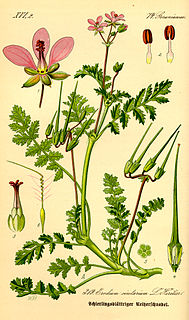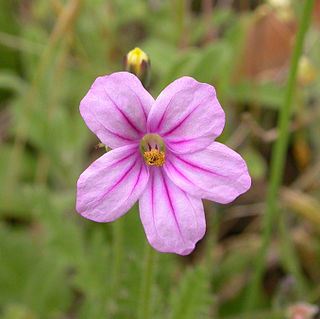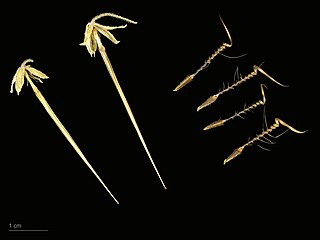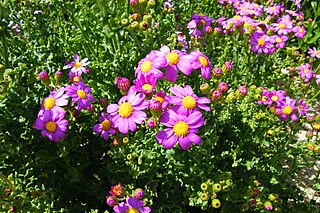
Erodium is a genus of flowering plants in the botanical family Geraniaceae. The genus includes about 60 species, native to North Africa, Indomalaya, the Middle East, and Australia. They are perennials, annuals, or subshrubs, with five-petalled flowers in shades of white, pink, and purple, that strongly resemble the better-known Geranium (cranesbill). Cultivated plants are known as filarees or heron's bill in North America, whereas in the British Isles they are usually called storksbills.

Erodium cicutarium, also known as common stork's-bill, redstem filaree, redstem stork's bill or pinweed, is a herbaceous annual – or in warm climates, biennial – member of the family Geraniaceae of flowering plants. It is native to Macaronesia, temperate Eurasia and north and northeast Africa, and was introduced to North America in the eighteenth century, where it has since become naturalized, particularly of the deserts and arid grasslands of the southwestern United States.

Vicia hirsuta or Ervilia hirsuta is a species of flowering plant from the large genus Vicia.

Cytisus striatus is a species of flowering plant in the legume family known by the common names hairy-fruited broom and Portuguese broom. This plant is native to the west of the Iberian Peninsula and northwestern Morocco.

Erodium malacoides is a species of flowering plant in the geranium family known by the common names Mediterranean stork's bill, soft stork's-bill and oval heron's bill. This is an annual or biennial herb which is native to much of Eurasia and North Africa but can be found on most continents where it is an introduced species.

Erodium botrys is a species of flowering plant in the geranium family known by the common names longbeak stork's bill, Mediterranean stork's-bill and broadleaf filaree.

Erodium moschatum is a species of flowering plant in the geranium family known by the common names musk stork's-bill and whitestem filaree. This is a weedy annual or biennial herb which is native to much of Eurasia and North Africa but can be found on most continents where it is an introduced species. The young plant starts with a flat rosette of compound leaves, each leaf up to 15 centimeters long with many oval-shaped highly lobed and toothed leaflets along a central vein which is hairy, white, and stemlike. The plant grows to a maximum of about half a meter in height with plentiful fuzzy green foliage. The small flowers have five sepals behind five purple or lavender petals, each petal just over a centimeter long. The filaree fruit has a small, glandular body with a long green style up to 4 centimeters in length.

Layia chrysanthemoides is a species of flowering plant in the family Asteraceae known by the common name smooth tidytips, or smooth layia.

Erodium cygnorum is a species of herb native to Australia.

California macrophylla, commonly known as roundleaf stork's bill, is a species of flowering plant in the geranium family, Geraniaceae. It was formerly placed in the genus Erodium, but was later placed in a monotypic genus of its own named California.

Minuartia rubella is a species of flowering plant in the family Caryophyllaceae known by several common names, including beautiful sandwort, mountain sandwort, Arctic sandwort, and boreal stitchwort. It has a circumboreal distribution, occurring throughout the northernmost Northern Hemisphere from the Arctic Circle on the Arctic tundra into the alpine climates of mountainous areas in temperate Eurasia and North America. It grows in rocky, moist, often barren habitat, including gravelly, sparsely vegetated slopes with little organic matter. It is a calciphile, growing in calcareous substrates such as soils rich in decomposed limestone.
Pseudobahia peirsonii is a rare species of flowering plant in the family Asteraceae known by the common names San Joaquin adobe sunburst and Tulare pseudobahia. It is endemic to California, where it is known from a few mostly small occurrences along the southeastern side of the San Joaquin Valley where it rises into the Sierra Nevada foothills. It grows in grassland and oak woodland habitat. It prefers heavy adobe clay soils. The plant became a federally listed threatened of the United States in 1997.

Ranunculus sardous is a species of buttercup known by the common name hairy buttercup. It is native to Europe and it can be found in many other areas of the world, including parts of the United States and Australia, as an introduced species and a roadside and lawn weed. It grows in many types of disturbed habitat, especially in moist areas. It is an annual or biennial herb producing a mostly erect, hairy stem up to half a meter tall. The hairy leaves are usually divided into three leaflets which are borne on petioles a few centimeters in length. The flower has usually five yellow petals each up to a centimeter long and five reflexed sepals. The fruit is an achene borne in a spherical cluster of up to 35.

Senecio elegans is a species of flowering plant in the aster family known by the common names redpurple ragwort, purple groundsel, wild cineraria and purple ragwort.

Silene noctiflora is a species of flowering plant in the family Caryophyllaceae known by the common names night-flowering catchfly, nightflowering silene and clammy cockle. It is native to Eurasia, but it is known on other continents as an introduced species and sometimes a weed. In North America, it is a common weed of grain crops in the Canadian prairie provinces and in much of the United States. It grows in fields and in other disturbed habitat.

Sisymbrium orientale is a species of flowering plant in the family Brassicaceae known by the common names Indian hedgemustard and eastern rocket. It is native to Europe, Asia, and North Africa, and it can be found throughout much of the temperate world as an introduced species and in some areas a common roadside weed. It is an annual herb producing a hairy, branching stem up to about 30 centimeters tall. The basal leaves are divided into deep lobes or toothed leaflets. Leaves higher on the stem have lance-shaped blades with small separate lobes near the base. The top of the stem is occupied by a raceme of flowers with light yellow petals each measuring up to a centimeter long. The fruit is a silique which can be up to 10 centimeters long.

Solanum triflorum is a species of nightshade known by the common names cutleaf nightshade and small nightshade. It is native to Argentina, but it is known on other continents, including Europe and Australia, as an introduced species and sometimes a weed. It is present throughout much of North America, where it is possibly non-native as well. It grows in many types of habitat, including disturbed areas. It is an annual herb producing spreading, decumbent stems up one meter long. It is hairy, the hairs sometimes associated with glands. The leaves are a few centimeters long and are deeply cut into toothlike lobes. The inflorescence bears two or three flowers each just under a centimeter wide when fully open. The flower is usually white, but is occasionally purple-tinged. The fruit is a berry roughly a centimeter wide.

Trifolium angustifolium is a species of clover known by the common names narrowleaf crimson clover, narrow clover and narrow-leaved clover.

Trifolium microcephalum is a species of clover known by the common names smallhead clover and small-headed clover.

Verbena bracteata is a species of verbena known by the common names bracted vervain, bigbract verbena, prostrate vervain, and carpet vervain. It is native to North America where it is widespread, occurring throughout the continent except for northern Canada and southern Mexico. It occurs in many types of habitat, especially disturbed areas. It typically blooms between the months of May and October. This annual or biennial herb produces several hairy, spreading stems up to 30 centimeters long forming a low mat on the ground. The hairy leaves are toothed or lobed. The inflorescence is a spike of flowers which is dense with long, pointed, leaflike bracts each up to 8 millimeters long. Each small tubular flower is about half a centimeter wide and white to pale purple in color.

















